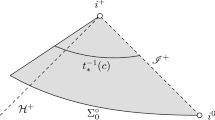Abstract
We study the eigenvalues of the MOTS stability operator for the Kerr black hole with angular momentum per unit mass \(|a| \ll M\). We prove that each eigenvalue depends analytically on a (in a neighbourhood of \(a=0\)), and compute its first nonvanishing derivative. Recalling that \(a=0\) corresponds to the Schwarzschild solution, where each eigenvalue has multiplicity \(2\ell +1\), we find that this degeneracy is completely broken for nonzero a. In particular, for \(0 < |a| \ll M\) we obtain a cluster consisting of \(\ell \) distinct complex conjugate pairs and one real eigenvalue. As a special case of our results, we get a simple formula for the variation of the principal eigenvalue. For perturbations that preserve the total area or mass of the black hole, we find that the principal eigenvalue has a local maximum at \(a=0\). However, there are other perturbations for which the principal eigenvalue has a local minimum at \(a=0\).
Similar content being viewed by others
References
Andersson, L., Mars, M., Metzger, J., Simon, W.: The time evolution of marginally trapped surfaces. Class. Quant. Gravit. 26, 085018 (2009)
Andersson, L., Mars, M., Simon, W.: Local existence of dynamical and trapping horizons. Phys. Rev. Lett. 95, 111102 (2005)
Andersson, L., Mars, M., Simon, W.: Stability of marginally outer trapped surfaces and existence of marginally outer trapped tubes. Adv. Theor. Math. Phys. 12(4), 853–888 (2008)
Baumgärtel, H.: Analytic Perturbation Theory for Matrices and Operators, Operator Theory: Advances and Applications, vol. 15. Birkhäuser Verlag, Basel (1985)
Booth, I., Fairhurst, S.: Isolated, slowly evolving, and dynamical trapping horizons: geometry and mechanics from surface deformations. Phys. Rev. D 75, 084019 (2007)
Booth, I., Kunduri, H.K., O’Grady, A.: Unstable marginally outer trapped surfaces in static spherically symmetric spacetimes. Phys. Rev. D 96(2), 024059 (2017). 11
Bussey, Liam: Investigation of the stability of marginally outer trapped surfaces in Kerr spacetime, B.Sc. Honours thesis, Memorial University (2020)
Chrusciel, P.T., Costa, J.L., Heusler, M.: Stationary black holes: uniqueness and beyond. Living Rev. Relativ. 15, 7 (2012)
Csukás, Károly Z.: On the stability of codimension-two surfaces in general relativity, M.Sc. thesis, Eötvös Loránd University (2015)
Dong, S.-H., Lemus, R.: The overlap integral of three associated Legendre polynomials. Appl. Math. Lett. 15(5), 541–546 (2002)
Galloway, Gregory J.: Constraints on the topology of higher dimensional black holes. In: Horowitz, G.T. (ed.) Black Holes in Higher Dimensions, pp. 159–179 (2012)
Hichami, H.: MOTS stability operator: perturbations around spherical symmetry, MSc. thesis, Université de Bourgogne (2018)
Jaramillo, J.L.: A Young-Laplace law for black hole horizons. Phys. Rev. D 89(2), 021502 (2014)
Jaramillo, J.L.: Black hole horizons and quantum charged particles. Class. Quantum Gravit. 32(13), 132001 (2015). 9
Jaramillo, J.L.: A perspective on black hole horizons from the quantum charged particle. J. Phys.: Conf. Ser. 600, 012037 (2015)
Kato, T.: Perturbation Theory for Linear Operators, 2nd edn. Springer-Verlag, Berlin (1976). Grundlehren der Mathematischen Wissenschaften, Band 132
Kunduri, H.K.: Spectrum of the MOTS stability operator for self-dual rotating black holes. Phys. Lett. B 797(134903), 4 (2019)
Mars, M.: Stability of MOTS in totally geodesic null horizons. Class. Quant. Grav. 29, 145019 (2012)
Messiah, A.: Quantum mechanics. Vol. II, Translated from the French by J. Potter, North-Holland Publishing Co., Amsterdam; Interscience Publishers, a division of Wiley, New York (1962)
Pook-Kolb, D., Birnholtz, O., Jaramillo, J.L., Krishnan, B., Schnetter, E.: Horizons in a binary black hole merger I: geometry and area increase (2020). arXiv:2006.03939
Pook-Kolb, D., Birnholtz, O., Jaramillo, J.L., Krishnan, B., Schnetter, E.: Horizons in a binary black hole merger II: fluxes, multipole moments and stability (2020). arXiv:2006.03940
Pook-Kolb, D., Birnholtz, O., Krishnan, B., Schnetter, E.: Existence and stability of marginally trapped surfaces in black-hole spacetimes. Phys. Rev. D 99, 064005 (2019)
Acknowledgements
The authors would like to thank José Luis Jaramillo for helpful comments and discussions on this problem. G.C. and H.K. acknowledge the support of NSERC grants RGPIN-2017-04259 and RGPIN-2018-04887, respectively.
Author information
Authors and Affiliations
Corresponding author
Additional information
Publisher's Note
Springer Nature remains neutral with regard to jurisdictional claims in published maps and institutional affiliations.
Appendix A: Wigner 3-j symbols
Appendix A: Wigner 3-j symbols
Here we review some properties of the Wigner 3-j symbols (as used above in the proof of Theorem 1.2), following the presentation of [19, Appendix C]. It is well known that the integral of three Legendre polynomials can be written in terms of Wigner 3-j symbols as
In general the 3-j symbols are difficult to compute explicitly, but the following special case
is easily obtained from [19, Eq. (C.23b)], so we have
More general (and complicated) formulas exist for integrals of associated Legendre polynomials. For \(m_3 = m_1 + m_2\) we have
see [10, eq. (30)]. Choosing \(m_1 = m_2 = m_3 = 0\), we get (32) as a special case. The other case we need is \(\ell _1 = \ell _2 = \ell \), \(\ell _3 = 2\), \(m_1 = m_2 = 1\) and \(m_3 = 2\). Using
together with (33), we find that
Rights and permissions
About this article
Cite this article
Bussey, L., Cox, G. & Kunduri, H. Eigenvalues of the MOTS stability operator for slowly rotating Kerr black holes. Gen Relativ Gravit 53, 16 (2021). https://doi.org/10.1007/s10714-021-02786-3
Received:
Accepted:
Published:
DOI: https://doi.org/10.1007/s10714-021-02786-3




